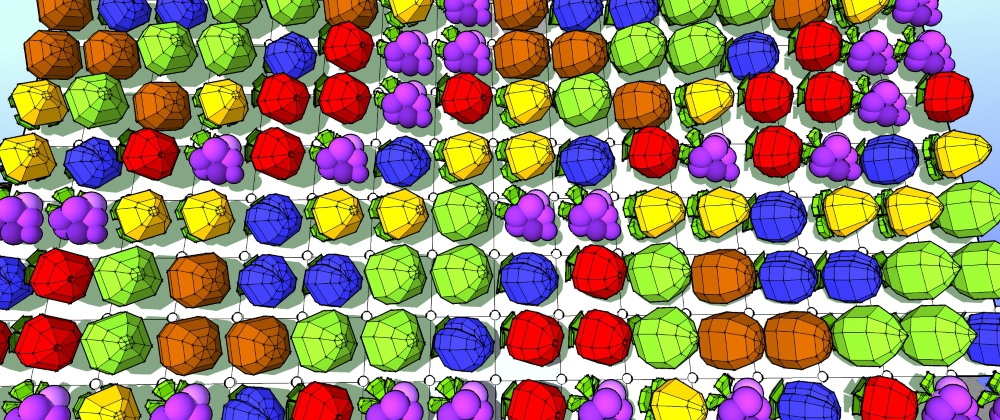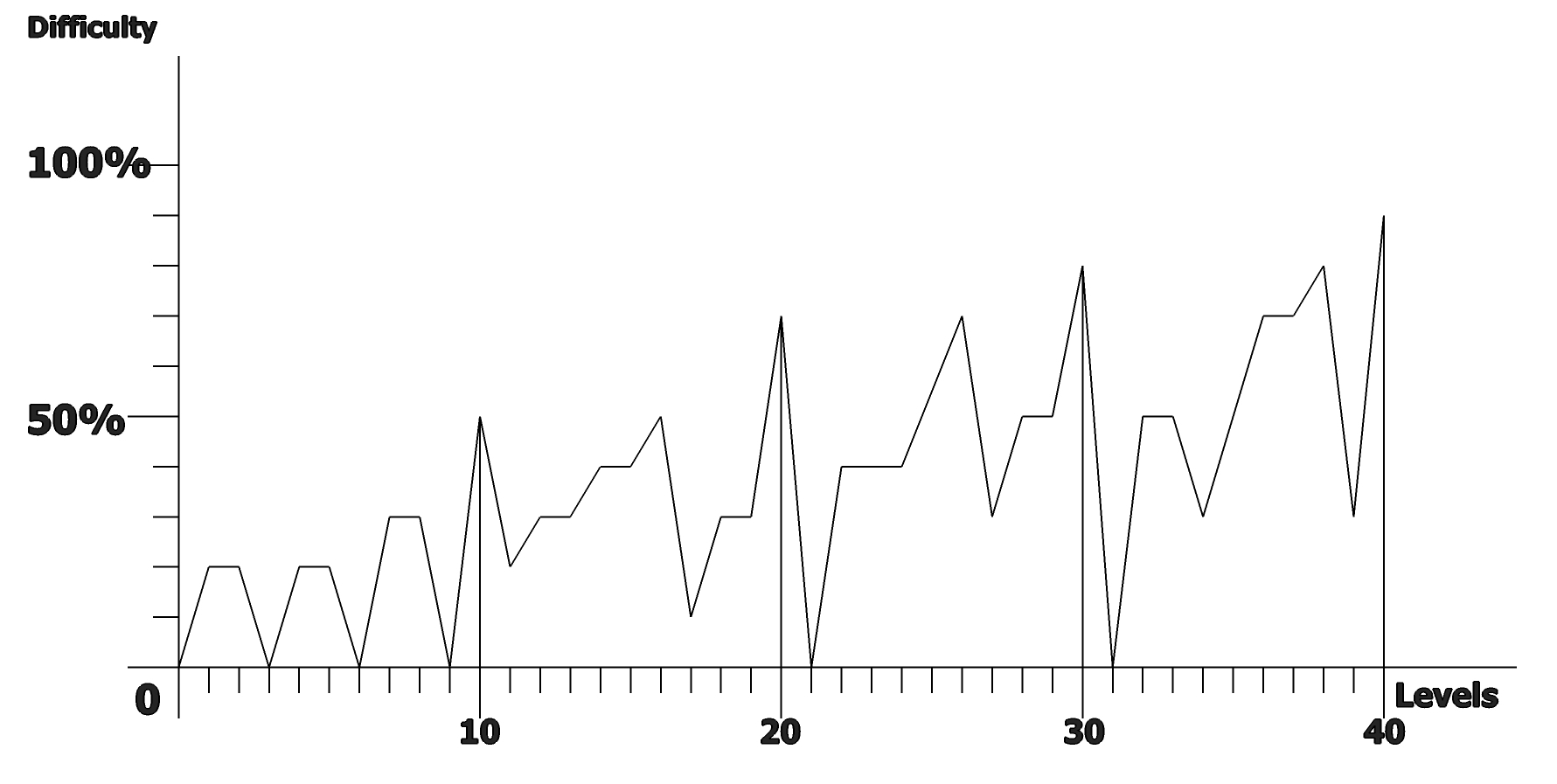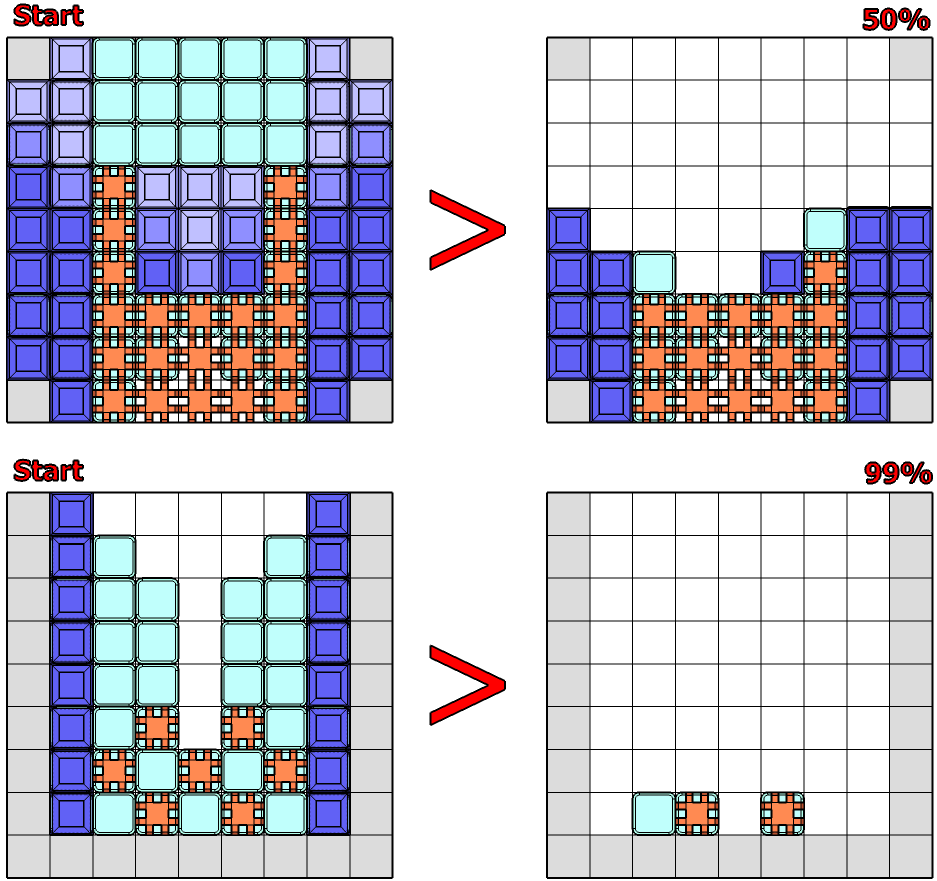Setting the overall balance of games three in a row

In continuation of the previous article , I want to share my experience in the preparation and maintenance of content for an ordinary game three in a row. Let's talk about the global balance curve, the balance of game modes, the assessment of their work and a number of nuances that arise during the development process.
The basic steps to adjust the balance of the game three in a row consists of building a complexity curve and distributing the main game mechanics to levels.
Let's start with the complexity curve

')
The difficulty is indicated as a percentage and is based on the ratio of victories to defeats at this level. Percentages are convenient for work, but mean little by themselves. It is necessary to tie them to the number of attempts that players spend on passing this level. This can be obtained from analytics, but if you do not have it, then in the next picture you can see the dependence of percent on the number of attempts.

This is the average data and you may have it different. The main thing here is that the complexity does not have a linear relationship, so the difference between 20% and 50% is actually small. Each percent is really important only when the complexity is above 80%. You can immediately build the complexity relative to the number of attempts and not to get involved in the interest - it already depends on your preferences.
I think it is not surprising for you that the first levels are of low complexity, and the twentieth and thirtieth are significantly higher than all previous ones. In games three in a row it makes no sense to do all the levels of one difficulty. Athletes do not shake the bar 100 times in a row, but break the exercise into several approaches. Everyone needs a break, a reward for the efforts and time to learn the past. The complexity should increase from level to level, and after the most difficult level - to subside. The complexity will decrease dramatically or gradually - it will be a matter of summing up the collected analytics. What works best in a particular case, then choose.
Let us analyze the curve in more detail:

1. The whole essence of the game. In a good way, you only have the first 3 levels to interest the maximum number of users who launched your amazing and incredible game. A significantly smaller number of players will reach level 5-6, so you should not put off uniqueness for later. From the first level lay out everything that you have. You say: “And at the Sweetie Davilka the Tale is wrong! We will lose all users if we don’t do like them! ”It’s worth answering by losing all users in any case, if you don’t understand the reasons why they leave and copying successful games here is not your friend. Of course, this is not a reason to immediately train the player in all boosters, plot twists and modes. Just show your chip, even if it will not greatly influence the gameplay from this level. If you show, you will immediately find out how effective your creative has been.
2. Educational levels are a place for matinees and debauches. New mode is not like everyone else? Go ahead - arrange the show! It is better to get rid of the text in the training and replace it with the most understandable animations and effects. Training levels should entertain and present new content to the player, regardless of where the player is now. The first level of the new location is the best place to reward the player with new content. Try to please them more often. And yes, the extra level for the gaming cell blocker is not exactly new content.
3. Players will forgive you all if you make your mistakes at the latest levels of the location. Here you can and should have the most difficult levels. At the next location the player will be congratulated, so why not make a little effort? Don't be too predictable, but complicating the game by the end of the episode is a normal practice.
4. A place where magic happens. When is the level perceived difficult? Will you be able to determine its complexity by one look at the level? Most likely no. Three in a row are unpredictable and full of surprises. You can rely on intuition, but you really understand the essence of the level only after you lose. Lose once - is it a lot or not? If you have a classic 5 lives, then one loss is not much. Difficult for you will be the level at which you lose all 5 lives. Several times in a row. Is it possible to put several difficult levels in a row? It is possible, but with the mind - only the miser pays twice, this does not apply to generous players. A thin line will have to look for yourself for a specific project.
We continue the balance of game modes

An example of a simplified table with complexity and game modes. Headlines, I hope, are quite eloquent.
The basic principle of the balance of game modes is fairly obvious - the player must be introduced into the game from simple elements to complex mechanics gradually. For example, the descent of elements is not the most suitable mechanic for the first level, since To successfully achieve the goal, you need a relatively large number of effective combinations and knowledge of the bonus elements of the game, breaking cells can also cause confusion - the most inattentive may not notice them (yes, yes, not all players have a wide gaming experience and your elements may not look like what the player is used to in another game). The first levels are best done with the simplest and most understandable goal, which is easy to achieve, for example, collecting the given game chips. In this case, even an inattentive player has a higher chance of completing the level of mindlessly collecting random combinations. The most complex mechanics should be shown only after mastering all the basic elements of the game. In consequence, you should not repeat the same game mode two levels in a row. This, of course, is not an axiom, but diversity is perceived more positively.
The main accounting tool is a spreadsheet. This is a very flexible option, although not perfect. It is best to have an advanced admin panel with hundreds of statistics and data right on one convenient screen. The most important thing in the table after the complexity curve is the notes and notes about the content, training, expected results and the history of edits. Competent data recording will help you more than once when it will be necessary to check all the creative and balance in numbers, for example, how the same level behaves when there is any feature on it and so on, etc.
If you have only 3-4 game modes, then still you should not mix them in one level. Why? It is more difficult to correct the balance, it is more difficult to make two goals equal at the level, it is more difficult for players to perceive the level itself.
Two goals per level is still half the problem, the biggest problem is when the same element can act as a level goal, or it can appear just like that, for example, helping to score points. Do not do it this way.
We complete the assessment of the work done.
How to process the data and check the success of your game? Yes Easy! If the game makes money - you're in chocolate, if you can say for sure why your game makes money - you are the best of the best.
We try to understand on the basis of understandable entities and without unnecessary mystification. For a developer, efficiency is determined by the amount of resources players spend at different levels. Three in a row effectively monetize only hitting players, which means there will not be any special spending on easy levels. All hope for complex and strong. And here you can already try to draw conclusions and set up experiments. There are no ready-made cases for all cases, but it is possible to single out general principles.
When balancing a level, there are the following most useful parameters - the average percentage of completion of a level with a loss, the frequency of loss with a shortage of 1-3 moves to win and the level of monetization.
The completion percentage is more visual:

The average completion percentage is useful in assessing the quality of a difficulty level. In a more global sense, this parameter will be needed to assess the clarity / availability of the entire game mode as a whole. The higher this percentage, the more the players fall out of the situation when it is profitable for them to buy additional moves to complete the level. The highest result, of course, will be on easy levels, because there the losses are rare and in most cases a step away from victory. The flip side of this indicator - the level that, from 10 attempts, ends 10 times in a step from victory, is not always perceived as difficult. Another problem of the indicator is that the level of descent of one element cannot be performed at 99% in principle, or you will have to collect analytics for such levels by the position of the element on the field.
A completely different situation at the levels where losing one step before a victory occurs every few games (FUUU-factor), for example, every fifth - these levels are perceived completely differently. In some situations, these levels are useful, but their number is directly proportional to the popularity of your game. Demotivating and losing players in this situation is very easy. However, such levels are excellent peyvola.
By the way, about payvol - it’s best to put them after the first 2-3 locations, when the players have definitely got acquainted with all the modes and understand how and when to use bonuses and boosters. As a rule, it is somewhere between 40 - 70m levels. The specific situation is important, but definitely you should not put them too far where a small number of players will go. The general recommendation is the most clear, reckless and interesting level that you can think of. Be sure to take care of your reward.
The most interesting, in my opinion, when analyzing the game - a comparison of game modes with each other. To get the most reliable results, try to choose levels that will have the same position relative to their locations. The same level, being in different positions in the same location, will have different degrees of monetization due to the fact that there is more sense to waste the boosters on the last levels.
Then you can infinitely delve into the details, tying the results to the weather forecast, the average percentage of good mood and other fortunetelling. But this is a topic for another discussion. I hope that my experience was interesting to you, you have questions and a desire to boast about your data analysis methods and the results of the decisions made.
Source: https://habr.com/ru/post/266121/
All Articles